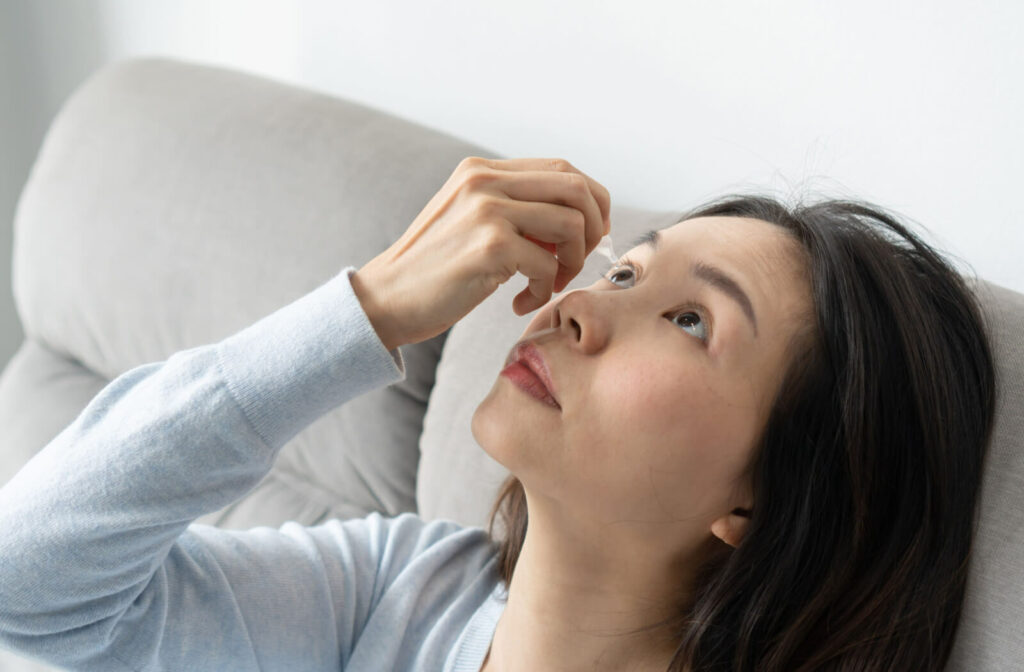If you’re experiencing dry eyes and headaches, you’re not alone. Many Canadians experience the frustrating symptoms of both conditions—and they can also occur together.
There is evidence to suggest that dry eyes and headaches might be linked, but there are also conditions that can cause both dry eyes and headaches at the same time. Determining what’s causing your symptoms is a crucial first step toward getting lasting relief.
If your head is aching and you’re also experiencing eye issues, there’s a chance a trip to your optometrist for a comprehensive eye exam may lead you to an unexpected solution that can relieve your symptoms.
What Is Dry Eye?
Dry eye disease typically appears when something affects your tear film.
Imagine your eye as a beautiful, intricate painting and the tear film as the protective glass covering it. Without that protection, the clear front dome of your eye, called the cornea, can be left open to the elements. Much like that painting, you don’t want your cornea getting dried out or damaged, so keeping your tear film healthy is important.
There are 2 types of dry eye:
- Evaporative dry eye is the most common type of dry eye. It often occurs when something negatively affects your meibomian glands—the tiny glands that line your eyelids and secrete an oil that helps stop your tears from evaporating too fast.
- Aqueous deficiency dry eye happens when your eyes simply don’t produce enough tears to stay hydrated and is often related to conditions that can affect your lacrimal glands—the tiny glands responsible for secreting the water portion of your tear film.
There are several factors that can increase your risk of developing dry eyes, including:
- Age: Our bodies may make fewer tears as we get older.
- Biological sex Hormonal changes can leave some people more susceptible to dry eye.
- Environmental factors: Hot, dry, windy, and sunny environments can all dry out your eyes.
- Certain medications: Antidepressants, antihistamines, and oral contraceptives are some of the medications that can reduce tear production.
- Medical conditions: Rheumatoid arthritis, thyroid disease, Sjögren’s syndrome, and Parkinson’s disease are only some conditions that can cause dry eyes.
- Allergies: Eye allergies can cause inflammation that blocks your meibomian glands and leads to dry eyes.
What Are the Symptoms of Dry Eyes?
Dry eyes can affect people differently, but some common dry eye symptoms include:
- Red eyes
- Burning
- Stinging
- Scratchiness
- A gritty feeling
- Feeling like something is stuck in your eye
- Watery eyes
There is also a recognized link between dry eyes and headaches, with some evidence suggesting that dry eyes may make migraines worse.
The Link Between Dry Eye & Headaches
Researchers aren’t sure why dry eye and headaches are linked, but some studies have already demonstrated the connection. People with migraine headaches appear to be more likely to experience dry eyes. What’s still unclear is if headaches cause dry eyes or if dry eyes cause headaches.
People who repeatedly experience migraines may have a broader range of triggers. So, the inflammation and irritation dry eye causes could bring forth a migraine for those already susceptible to headaches or migraines.
Dry eye and headaches may also be linked through separate health conditions. For example, both dry eyes and headaches are symptoms of digital eye strain—or computer vision syndrome—and if you’re getting hit with a double dose of headaches and dryness, it could be related to your screen time.
Some potential links between dry eye and headaches include the following:
- Cluster headaches that are confused with dry eye because they cause pain right behind the eye socket
- Dry eyes and headaches simultaneously caused by Sjörgen’s syndrome
- Eye strain leading to both dry eyes and headaches
Sometimes, treating the source of dry eye and headaches can be essential for getting relief from both issues.

Treating Dry Eye
If you often find yourself dealing with dry eyes and headaches together, consider reaching out to your optometrist. These issues might be connected, and getting them assessed is often better than leaving them to worsen.
We can diagnose dry eyes, find potential causes, and offer guidance on managing your symptoms. There’s no single solution for every person’s dry eye symptoms—they can be as unique as you are— but the treatments for dry eyes can include:
- Preservative Free Artificial tears
- Medicated eye drops
- Skincare products to keep your eyelids and face clean
- RF
- IPL
- LipiFlow treatments
- Celluma
- Manual expressions
- Nutritional supplements, such as omega-3 supplements
- Warm compresses
Find Relief for Your Head & Eyes
What’s better than treating dry eyes? Preventing them in the first place! You can take proactive steps before the first symptoms appear—and before the headaches start—by eating a balanced diet, taking frequent screen breaks, and visiting our team at Dr. Zargar Eyecare for regular comprehensive eye exams.
We use reliable diagnostic techniques and technology like our Meibomian Gland Evaluator and LipiView dry eye assessment tools to examine your tear health and recommend treatments that can address the root cause of your dry eyes.
Hit the refresh button on your eyes and book your appointment at our dry eye center today.

